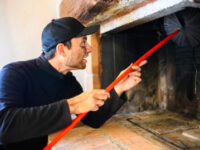A Solid Defense: Why Roof Maintenance Is Essential for Homeowners
 Just like a doctor’s visit, routine maintenance prevents problems before they escalate. It also helps extend the roof’s lifespan, saving homeowners from costly repairs or replacements.
Just like a doctor’s visit, routine maintenance prevents problems before they escalate. It also helps extend the roof’s lifespan, saving homeowners from costly repairs or replacements.
Moisture accumulation can lead to mold and mildew, which are a health hazard for house occupants. Routine roof inspections from Roofing Contractors South Jersey help identify and address areas susceptible to moisture, preventing water leakage.
Check the Shingles
A properly-maintained shingle roof is more than just a selling point for potential home buyers; it’s also your first line of defense against the elements. Taking time for regular inspections can identify signs of damage before they become major problems, saving you stress and money in the long run.
While many people believe that roof inspections should only be done once a year, it’s actually best to do them on a seasonal basis. This allows you to catch problems that are specific to each season, like hurricanes or snow storms. During these inspections, look for shingles that are loose or missing. Curled shingles are an indication of early aging, while missing ones can cause leaks and other damage.
Another thing to keep an eye out for is the flashing around chimneys or vent pipes. This should be inspected and caulked on a regular basis to prevent water from seeping into your house. The same goes for the flashing along valleys and other roof slopes.
You should also regularly clear away leaves and debris from the shingles. Over time, this can cause shingles to become oversaturated with moisture, which leads to rot and other damage. Additionally, piles of leaves can retain moisture and create a breeding ground for insects that can damage the shingles and wood framing of your home.
When you’re inspecting the shingles, you should also be looking for granules that may have eroded or dislodged. These sand-like granules protect the asphalt layer of your roof from the sun’s damaging UV rays. Loose granules can also indicate that it’s time to replace your roof.
You should also regularly check inside your home for stains and other discoloration. These can be a sign of a leaky roof, even if the stain isn’t directly above where the problem originated. In addition, any staining in the attic can be a sign of a leaky or damaged roof that should be fixed as soon as possible.
Check the Flashing
One of the primary reasons roof leaks occur around chimneys and corners, and also at valleys where two slopes of the roof meet, is because the flashing has been improperly installed or is missing altogether. In these cases, water that is supposed to be flowing away from the roof ends up seeping through and damaging drywall, insulation, and even underlying structural components. As a result, it’s very important to inspect the flashing regularly and ensure that it is in good shape.
Most roofing professionals recommend that you do regular visual inspections of the flashing with binoculars from the ground or a ladder if it is safe to do so. However, this may not give you a very complete picture of the flashing condition. In most cases, it will be necessary to climb on the roof to perform a more thorough evaluation of the flashing.
The flashing is a thin material that’s designed to tie the elements of the roof together, eliminating a seam where water could leak or rot. It is generally attached to the shingles with nails or screws that can sometimes wiggle loose. Checking these items regularly is very important, and if they are raised, the nails or screws should be hammered down or tightened to keep them in place.
Some roof features, such as a chimney, require a two-part flashing system that includes base and counter-flashing. The base flashing is placed under the shingles, while the counter-flashing sits above it and helps to direct rainwater away from the chimney and the roof decking. Both pieces of flashing should be properly fastened and sealed with a high-quality caulking to prevent leaks.
If you are concerned that your flashing has been compromised, a professional roof repair expert can take a look at it during a standard roof inspection and make recommendations about repair or replacement. It is best to hire a professional for this work because there are many details involved that should be taken into consideration when making a decision about replacing the flashing.
In general, a roof should be inspected by a professional at least once every year, to make sure that the flashing is in good shape and is providing the proper protection for the other elements of the structure below it. Failure to do this can lead to a host of problems, including damage to the drywall and other interior components, and the need for costly repairs or replacements.
Check the Gutters
When it comes to proper roof maintenance, gutters and downspouts are an integral component of your home drainage system. If your gutters become clogged with leaves, debris and even animals, water can’t flow properly down the roof overhangs and into the downspouts, which then divert water away from the house. This can cause moisture problems in the basement and foundation areas of your house, which can be costly to repair. Cleaning the gutters regularly will prevent this from happening, and it will help extend their life as well.
It’s recommended that you inspect and clean your gutters on a regular basis throughout the year to ensure they are functioning properly, especially before rainy weather arrives. If your gutters are clogged with debris, they can cause standing water on the roof and in the eaves, which can damage the shingles and soffits. Water in the soffits can lead to wood rot, insect infestation, and a host of other issues. In addition, the standing water can eventually cause foundation cracks, which can threaten the structural integrity of your home and the items stored in its basement.
Inspecting and cleaning the gutters regularly will also help prevent them from becoming clogged in the first place. A quick visual inspection from the ground level will allow you to spot any sections of your gutters that appear low, out of place or out of alignment with the rest of the gutter system. You can then either adjust them by bending the hangers or install additional hangers in those low spots to correct the problem and improve your home’s drainage system.
It’s also a good idea to trim any tree branches that may be growing too close to your roof, as they can easily break during heavy storms or natural disasters. These limbs can scrape the surface of your roof, which can cause shingle damage. In addition, they can also snag on the soffits or fascia, which can create holes and leaks. A final step in your visual roof maintenance inspection should include a quick check of the soffit and fascia to make sure the caulk is still sealed and doesn’t need to be redone.
Check the Soffit
The soffit is a crucial element of the roof system. It covers the eaves and protects the rafters from moisture. It also provides ventilation to the attic and gives your home a finished look. It can be difficult to notice damage to your soffit or fascia, but this is why it’s important to inspect them regularly. If you catch signs of damage early, they can be repaired before they become serious problems.
Check for holes in the soffit to make sure they are sealed and protected from water leaks and pests. Holes are usually the first sign of a problem, but it’s important to check the entire soffit design to see if there are other issues. For example, if the soffit is curled, it may need to be replaced to prevent further damage.
Fascia and soffits are often made from wood, which can rot or be damaged by pests and bad weather. uPVC fascia and soffits are an excellent choice for homeowners who want to avoid these problems. They are also easier to clean and require less maintenance than wood options.
Another important function of a soffit is to keep small animals and bugs from getting into the attic and causing harm. This is why it’s crucial to ensure the soffit has proper spacing to prevent these pests from accessing the attic without sacrificing attic ventilation.
When inspecting the soffit, it’s a good idea to test the material for dry rot. This can be done by tapping the soffit lightly with a screwdriver or similar tool. If the soffit starts to break apart, it’s likely that it has dry rot and will need to be replaced immediately.
It’s also a good idea to check the space under each rafter tail for a colony of termites. If there are any, it’s a good idea to contact a local pest control company as soon as possible. Termites can cause severe damage to your roof and home and should be dealt with quickly to prevent an infestation. This will save you money and time in the long run.






